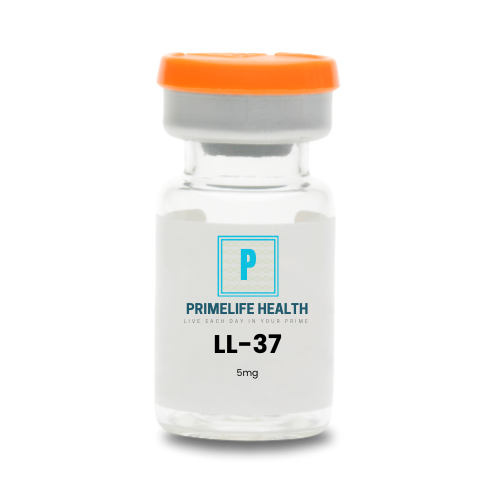Prime Life Health
LL_37
LL_37
Couldn't load pickup availability
LL-37 is a naturally occurring antimicrobial peptide derived from the human cathelicidin protein. It plays a crucial role in the innate immune system, defending against bacterial infections by interacting with cell wall molecules and perforating cytoplasmic membranes, leading to bacterial cell death.
Benefits of LL-37:
-
Antimicrobial Activity: LL-37 exhibits broad-spectrum antibacterial effects against various pathogens, including Escherichia coli and Staphylococcus aureus.
-
Anti-Biofilm Properties: It has been shown to disrupt biofilms formed by multiple Gram-positive and Gram-negative human pathogens, enhancing its effectiveness in resolving polymicrobial infections.
-
Wound Healing: LL-37 promotes wound healing by modulating inflammatory responses and stimulating tissue regeneration. Clinical trials have demonstrated significant healing improvements in hard-to-heal venous leg ulcers with topical application of LL-37.
-
Immune System Modulation: Beyond its antimicrobial properties, LL-37 influences the immune system by enhancing responses to viral infections and stimulating mast cell activation, crucial for defense against bacteria.
Dosing Protocols:
Clinical data on LL-37 dosing is primarily available for topical applications
-
Topical Application: Applied at concentrations of 0.5 to 1.6 mg/mL on wounds, showing significant healing benefits over a 4-week period.
-
Subcutaneous injections: clinical studies are lacking, and dosing protocols are not well-established. Anecdotal reports suggest doses of 125 mcg daily via subcutaneous injection.
Potential Adverse Effects:
LL-37 is generally considered safe when used topically, with clinical trials reporting good tolerability.
-
Injection Site Reactions: Redness, swelling, or irritation at the site of injection.
-
Inflammatory Responses: High concentrations may induce inflammatory reactions, including erythema and edema.
-
Potential Toxicity at High Doses: In animal studies, low doses (100 μg/kg) did not induce observable toxicity, but high doses (3,000 μg/kg) resulted in adverse effects and appeared to be toxic to organs affected by sepsis.
It's important to note that LL-37 has been implicated in various pathological conditions. For instance, its overexpression is associated with certain cancers, such as ovarian, lung, and breast cancers, suggesting a pro-tumorigenic role. Conversely, it appears to exert anti-tumor activity in colon cancer cell lines. Additionally, long-term administration of LL-37 in animal models has been shown to induce irreversible rosacea-like lesions, indicating potential risks with prolonged use.
Given the limited clinical data and potential for adverse effects, particularly with systemic administration, it's crucial to consult with a healthcare provider before considering LL-37 therapy. Further research is needed to fully elucidate the safety profile and therapeutic potential of LL-37.
NOTE: This is not medical advise. All peptides are for research purposes only.
Share

Collections
-

Anti-Aging
Peptides are a powerful tool in the fight against aging, working to...
-

Weight Loss
Peptides like Semaglutide, Tirzepatide, and AOD-9604 are designed to help support weight...
-

Anti-inflammatory
Anti-inflammatory peptides are powerful therapeutic agents that help reduce inflammation, promote tissue...




